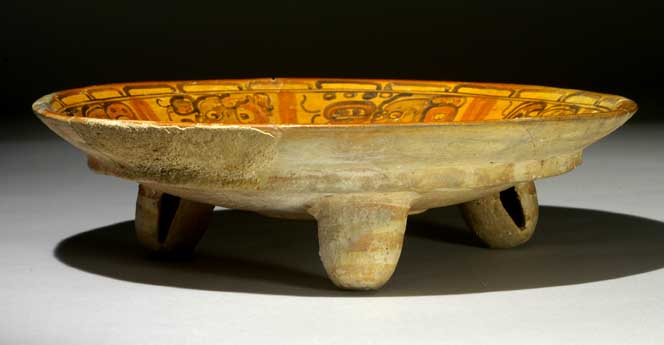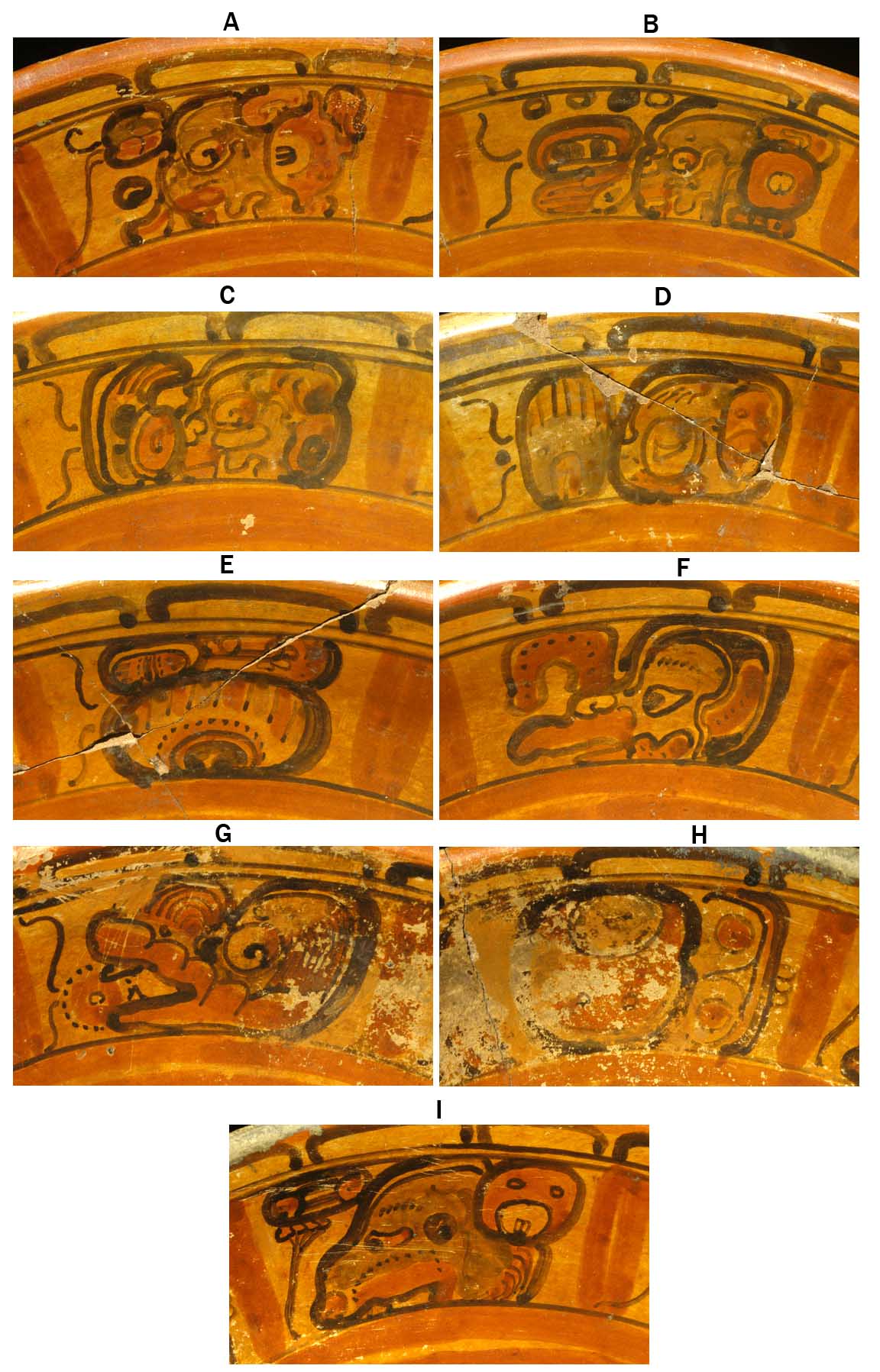Mayavase.com Research Material


A tripod plate (the legs have clay beads that rattle).
The text is a variant of the dedicatory text (The PSS) including the word for plate (lac)
and ends with the word ko ba al which has the meaning of genitals. It is probably shorthand
for the entire phrase seen on vase K504 (In the vase are the seeds of the genitals). the phrase is a
euphemism for corn gruel .

The entire rim text follows.

COMMENTS
From David Mora-Marin
The text seems to show something like the following:
a-LAY / 4-T548-K'AL-??SKULL / yi-chi / ?b'a-??[?T533] / ?u:tz'i-b'a- / -li / ?u- / -la-u / ko-?-?b'a[?la]
In the last glyph block, block I, showing ko-?-?b'a[?la], I included the [?la] sign with a question mark because it is not upside down. However, given that T501 is upside down in glyph block E, showing ?u:tz'i-b'a-.
So maybe the scribe or scribal school responsible had switched them somewhat systematically, inverting T501 upside-down, which normally wasn't, and reverting T533 back to its normal position. Thus this plate is quite interesting from a paleographic perspective. Another paleographic note pertains to the barroque-like volutes, which I recall Stephen Houston calling "superfluous" during the 2005 Maya Meetings; they are quite consistently applied in this text, more so than in most texts that have them. As a side note, I have had the suspicion that such ornamental volutes arose originally with T51 ta, and given the frequent appearance in PSS texts of T51 ta, such volutes may have been applied through a analogy to other signs within the PSS. This text could support such an idea, given glyph G, the SHARK glyph which is used as phonetic u, and which also has the ornamental volutes and part of T51 inside the mouth. I doubt the T51-like sign is intended to be read
here: Glyph G in this text follows what appears to be ?u:tz'i-b'a-li in Glyphs E-F, and this is usually followed by another possessed noun (e.g.
yu-k'i-b'i, u-la-ka, u-na-ja-la, etc.), and here Glyphs G and H may have been intended to spell u-lak together (interestingly, if so, the u- of u-lak would have been spelled twice, with one instance appearing after the <la> sign, where one would have expected to find T25 ka instead; however, I agree with Justin that this is likely a case of u-la-ka, though an unusual one at that).
Last, about the ko-b'a-la expression on K504: Schele did transliterate it as kob'al and translate it as 'genitals' or 'seeds'. I am not sure what her source might have been, and I would appreciate clarification in this regard. I have only found in the Cordemex the entry KOBOL 'la calidad, condición o ser de alguno, o la estima en que se tiene' and 'genitales: el sexo, vocablo honesto', but it does not relate very clearly to 'seeds' or 'corn'. The term KOB appears on the same page in the Cordemex (p. 324) as 'maíz dañado o perdido o corrompido, que se mojó en la caña, o maíz añublado'. Unless rotten corn was used to prepare some kind of drink I am not sure what the term ko-b'a-la is doing in these cases; presumably it could be the case that its meaning has shifted through pejoration, and that it originally did not have negative connotations.
From Sam Edgerton
Just an amateur observation. Your "plate" is really a shallow bowl. The fact that the legs were also rattles suggests that the receptacle was meant to be shaken. Perhaps, it was intended for a symbolic preparation of atole; in a kind of ritual mixing action in which a small amount of corn meal and water, accompanied by music and dancing, is titrated by a shaman/priest as prelude to some important agricultural ceremony. Actually, the shape of your plate reminds of a Greek kylix, also a shallow cup for ritual drinking.